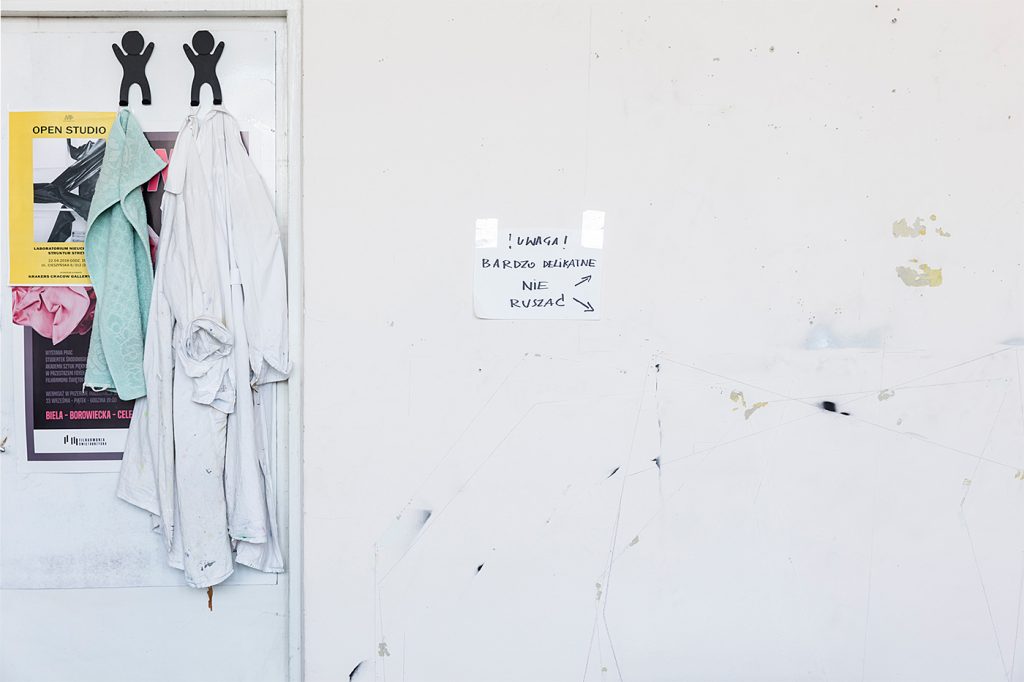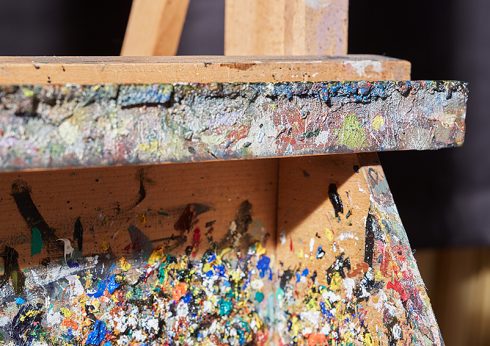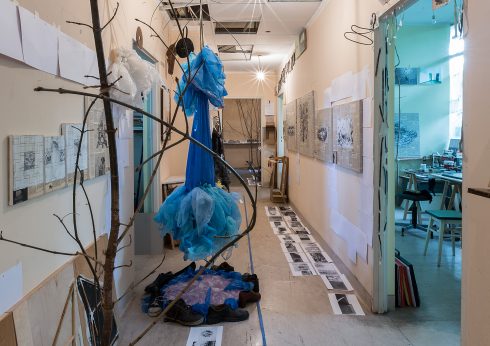
Martyna Borowiecka’s studio
Anna Stankiewicz Małopolski Instytut Kultury w Krakowie Martyna Borowiecka interviewed by Martyna Nowicka M.N.: In a previous (...)Martyna Borowiecka interviewed by Martyna Nowicka
M.N.: In a previous conversation you mentioned that for you, a studio is like your own room, that this is the only space you share with no one. And yet most artists of your generation rent spaces to work together, often as quite a large group. Is it important for you to work on your own?
M. B.: I’ve been working here alone for just a year. Earlier I rented a place to work from someone or someone worked next to me. I think that sharing a studio not a question of choice but of financial constraints. It is easier to cope with the bills when there are more of you. At the same time, I have the feeling that even the spaces I shared with someone became mine: I considered them the place of my work, my own space. I made the decision to rent a room in Telos by myself, for myself. I came with the thought that this is a place for me and I can invite somebody to work with me, but I take the responsibility for the administrative matters and bills, which has made me feel at home here.
I come from a large family so I didn’t have my own room as a child or teenager, I’ve always shared with someone. Here I find fulfilment but also satisfy needs that are many years old. I have various things on the walls, like teenagers who hang photos of idols, slogans, and posters. A studio is not a public space but it’s not fully private either, so I want to show the things that define me. I might have unfinished works here yet they are displayed to be looked at, perhaps this is a particular kind of controlled exhibitionism?
M.N.: Do you behave here differently than at home? Is this the place where everything you do originates, or is it rather a stop on your creative path?
M. B.: I actually treated my previous studio as a stop: I could do things elsewhere, work at home. It’s different with this place – this is a place of creative work. All the things that I have gathered at home: stocks of paint, cloths – I’ve moved them here. I like building zones – for relaxation, eating, sleeping. But when you deal with art, processes happen all the time – watching a serial or going for a walk you suddenly experience a spark and know you should follow this path. Even at home I don’t relax as deeply as other people do. It’s not that I keep thinking about painting nonstop, only that the painting is within me and it’s hard to set boundaries, to control the fact that there is always work in progress.
My vision of a studio is that I simply work here. I come prepared –I make food at home, pour coffee into a thermos. I don’t have a kitchen annexe here, or an armchair. This is not a place to spend time together and meet people I know. I’ve never smoked, so I don’t feel the need to move away, light a cigarette, take a sip of coffee, and think. I care for the hygiene of work: as a rule, I don’t spend much time here: I don’t want to get discouraged, I’m absolutely focused on performing the activities. Of course, every day is different. Sometimes paintings take the upper hand, and I am scared by having a model, an actual still life (that is the stretch film on the wall) and an empty canvas. I know what that painting could look like, but the number of things in front of me that I need to do seems huge. When I get into that rhythm – turpentine, paints. The painting develops as if without my participation.
M.N.: Are you the medium of your painting?
M. B.: This is how I sometimes feel. While on the way to the studio I start planning what I would like to do. And then I arrive and the hand starts moving on its own. I consider it a contemplation of an object: a conversation with an object. I penetrate it and in a way, the process carries on by itself. I barely think about technicalities: such a stroke of a brush here, such a reflection there – I only participate in the dialogue with an object. Sometimes I believe there is still so much ahead of me, you can still see the ground, and then it’s suddenly finished. I take a step aside, I look at it from a distance and I suddenly see it: it is already here. Planning is a good thing but it’s even better to let yourself be surprised.
M.N.: Has Telos in Cieszyńska influenced your work? Do you think that this space has shaped what you did in previous years?
M. B.: Since I moved to work here I’ve devoted most of my time to working with black stretch film. This is the studio where I made my PhD project, that is a wall of paintings presenting black stretch-type film; it was painted directly from life. It all began here, and it all also finished here. During the PhD I was fascinated with illusionist painting – first I painted fabrics, the folds. I was interested in the dialectic between the physicality of the canvas and what is in front of the foreground, superimposed. Then, already in this studio, I started my PhD journey and I focused on the stretch film. I associate this place with that film – and I don’t know to what degree the space influenced my selection of the subject (for obviously there are many other factors) but the concept of an illusionist wall originated in this building. I wanted the effect to be spectacular, scenery-building.
M.N.: You have recently started moving in another field, making paintings based on collages. It is a kind of farewell to the studio, from which you will have to move out of by the end of the year, isn’t it?
M. B.: Yes. I very much wanted to finish my doctorate at Cieszyńska, and to defend the degree here. My new method is not connected so directly to this space, I don’t have to observe that film. Now when I have to pack I won’t find it a problem. I can say with satisfaction that I have completed my task here. I’ve worked from a non-standard real object that was nonetheless a still life. Following the assumptions of illusionist painting I’ve tried to wipe away the traces of the brush, to withdraw from what I present, to delude. This gives you a frame, which I liked, but I also needed to have by my side something that wasn’t there in my painting, to create a particular mood board, a board with inspirations.




